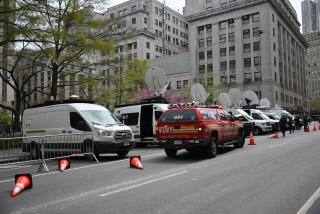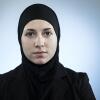Sharing a faith in each other’s goodwill
Rabbinical student Jessica Koss paused in front of the mosque and carefully wrapped a turquoise and green scarf around her head so that all her hair was covered.
She tied the loose ends into a bun at the back of her neck before entering the Masjid Omar Ibn Al Khattab for the Friday prayer service.
With her were two other student members of the Hillel Jewish Center taking part in daylong “getting to know the other” events between Muslim and Jewish student groups at USC. The events on Friday, which began at the mosque and ended hours later for Shabbat dinner at Hillel, were part of a national “twinning campaign” to establish synagogue-mosque partnerships to combat Islamophobia and anti-Semitism.
“I think it’s really a good opportunity to talk openly with each other,” said Koss, who is in her second year at the American Jewish University. “As someone who’s going to be a rabbi, I look at it as an opportunity to understand a background that I don’t know anything about.”
Inside the mosque, the three students were greeted by Hebah Farrag, an assistant director at USC’s Center for Muslim-Jewish Engagement, who gave the two other women flower-print scarves before they entered the prayer room. They walked past men and women sitting on the bright blue-and-beige carpet to an area almost empty except for one other person, with more than 30 folded chairs set out for guests. At the front of the room, Ahmed Gablawi delivered a sermon urging Muslims to focus on similarities, rather than differences, with other faiths.
“Argue not with the people of the book except with that which is best,” Gablawi said, meaning discussions with Christians and Jews should be civil.
Koss took notes during the sermon. Beside her, Nina Gordon-Kirsch, a USC environmental studies sophomore, wrote down questions as the Muslim congregation prayed in Arabic -- bending, prostrating and rising at the direction of the imam. She wondered what each movement meant and what was being said.
“I had a lot of questions, I don’t know so much,” she said.
The idea for the twinning campaign grew out of an interfaith meeting last November in New York, where Jewish and Muslim leaders gathered in the hope of building stronger ties. They hit upon the idea of pairing mosques and synagogues.
They’d hoped to attract 50 congregations -- 25 Jewish, 25 Muslim -- but wound up with double the number in cities throughout the United States and Canada, including Atlanta, Boston, Denver and Minneapolis, in addition to Los Angeles and Santa Monica.
To promote their campaign, 13 rabbis and imams appeared in a full-page advertisement in the New York Times this month; several also have been featured in a public service announcement on CNN, denouncing religious hatred and calling for peace.
A rabbi and imam who kicked off the national campaign last Monday at Temple Emanuel of Beverly Hills reiterated that message before an audience of 200.
“Jews and Muslims, as the children of Abraham, not only do we share a common faith, but we share a common fate,” Rabbi Marc Schneier, president of the Foundation for Ethnic Understanding, told the gathering. His organization has coordinated the interfaith effort with help from the Islamic Society of North America, the Muslim Public Affairs Council and the World Jewish Congress.
Dr. Muzammil Siddiqi told the temple audience that the two faiths have coexisted largely in peace since Islam’s birth 1,400 years ago.
Siddiqi, director of the Islamic Society of Orange County, pointed out the many similarities between Muslims and Jews. Both, he said, revere the same biblical patriarchs and prophets, including Moses, whose name appears 134 times in the Koran, more than that of any other prophet.
The Muslim religious leader denounced anti-Semitism as “evil.” He called on his fellow Muslims to do the same and for Jews to fight Islamophobia.
“We have to change ourselves, then we can change others,” said Siddiqi, who is also chairman of the Fiqh Council of North America, the highest body of Islamic jurisprudence in the United States. “Muslims and Jews of America can . . . show this is possible to work together. This is the message of the Torah. This is the message of the Koran. This is the message of the Gospel.”
After Schneier and Siddiqi spoke, the audience broke into two groups. About 25 Muslim men and women conducted their Isha (evening) prayers in a corner of the temple’s social hall, while about 50 Jews, their shoes removed out of respect for Muslim tradition, observed from the back of the room.
Afterward, several of the Muslim visitors walked next door to a small chapel to watch Jews finishing their evening Ma’ariv prayers.
The program provided a first tentative step of “twinning” between Temple Emanuel and the King Fahad Mosque in Culver City.
Usman Madha, the mosque’s director, said he was pleased with the new relationship.
“The first step is for the communities to get to know each other,” he said. “Once that’s done, we can tackle bigger issues.”
Rabbi Laura Geller voiced excitement at the prospect of congregants from both places getting to know one another over the next six months.
“We want to build relationships of trust,” Geller said. “As we get to know each other, we’ll see that we have the same concerns.”
Similar themes emerged at the mosque near USC. At the Masjid Omar Ibn Al Khattab, Koss was discovering that the religions have similarities in worship too. The afternoon Muslim prayer service reminded her of the Mincha, the Jewish afternoon prayer service.
“I’m like, well, I’m at an afternoon prayer, so I said some [Jewish] prayers in my head,” she said afterward.
Covering her head also wasn’t such a departure for her because some women in the Jewish faith also hide their hair.
Shani Shousterman, a music junior, echoed Koss’ thoughts of similarities between the religions.
“I mean, every religious center has this air of importance and spirituality,” she said. “And [I] compared it to the synagogues which I’m used to.”
--
raja.abdulrahim@latimes.com
More to Read
Start your day right
Sign up for Essential California for news, features and recommendations from the L.A. Times and beyond in your inbox six days a week.
You may occasionally receive promotional content from the Los Angeles Times.







